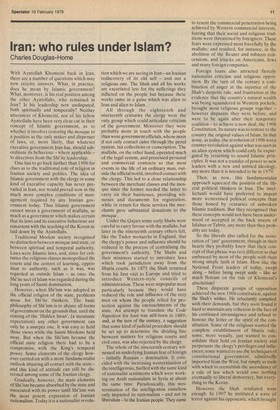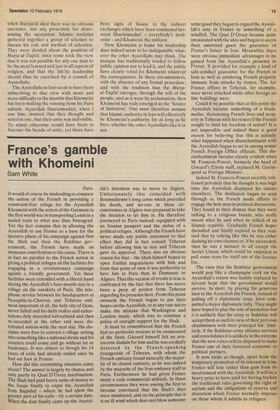Iran: who rules under Islam?
Charles Douglas-Home
With Ayatollah Khomeini back in Iran, there are a number of questions which may now receive answers. What, in practice, does he mean by Islamic government? What, moreover, is his real position among the other Ayatollahs, who remained in Iran? Is his leadership now undisputed, both spiritually and temporally? Neither utterances of Khomeini, nor of his fellow Ayatollahs have been very clear cut in their concept of Islamic government, as to whether it involves restoring the mosque to a position as the only maker and dispenser of laws, or, more likely, that whatever executive government Iran has, should subordinate its behaviour — where applicable — to directives from the Shi'ite leadership.
One has to go back further than 1906 for clues as to the traditional role of religion in Iranian society and politics. The idea of Islamic government with the clergy in some kind of executive capacity has never prevailed in Iran, nor would prevail now in the much more complex conditions of management required by any Iranian government today. Thus Islamic government cannot mean a government of mullahs, so much as a government which makes certain that its laws and its executive behaviour are consistent with the teaching of the Koran as laid down by the Ayatollahs.
Traditional Moslem society recognised no distinction between mosque and state, or between spiritual and temporal authority. Laws were Islamic laws, and, since for centuries the religious classes monopolised the courts and the centres of learning, opposition to authority, such as it was, was regarded as outside Islam — as once the Shi'ite sect of Islam was regarded during the long years of Sunni domination.
However, when Shi'ism was adopted as the official religion of the state, problems arose for Shi'ite thinkers. The basic philosophy of Shi'ism is to abjure all forms of government on the grounds that, until the coming of the 'Hidden Iman', (a messianic expectation) any other government can only be a usurper one. It was easy to hold those views while the Sunni Moslems held sway. But when the Shi'ism became the official state religion there had to be a compromise with the King's temporal Power. Some elements of the clergy however carried on with a more fundamentalist outlook abjuring all contact with the state — and this kind of attitude can still be discerned among some of the Iranian clergy.
Gradually, however, the main elements of Shi'ism became absorbed by the state and associated with its power until Shi'ism was the most potent expression of Iranian nationalism. Today it is a nationalist revolu tion which we are seeing in Iran — an Iranian rediscovery of its old self — and not a religious one. The Shah and all his works are excoriated less for the sufferings they inflicted on the people but because these works came in a guise which was alien to Iran and alien to Islam.
All through the eighteenth and nineteenth centuries the clergy were the only group which could articulate criticism of the government. Moreover they were probably more in touch with the people than were government officials, whose main if not only contact came through the penal system, tax collections or conscription. The mullahs, on the other hand, operated much of the legal system, and processed personal and commercial contracts so that most events in the life of an ordinary. man, outside the official world, involved contact with the clergy. This led to a close relationship between the merchant classes and the mosque since the former needed the latter to carry on their businesses, providing witnesses and documents for registration, while in return for these services the merchants gave substantial donations to the mosque.
Under the Qajars some early Shahs were careful to curry favour with the mullahs, but later in the nineteenth century others felt, like the Tudor monarchs in England, that the clergy's power and influence should be reduced in the process of centralising the government's authority. The Shahs and their ministers started to introduce laws which took jurisdiction away from the Sharia courts. In 1875 the Shah returned from his first visit to Europe and tried to introduce Western-style councils of administration. These were unpopular most particularly because they would have reduced the role and influence of the very men on whom the people relied for protection against the encroachments of the state. An attempt to translate the Code Napoleon for Iran was still-born in 1889; and, at the turn of the century, a suggestion that some kind of judicial procedure should be set up to determine the dividing line between matters for religious courts and civil ones, was also rejected by the clergy.
The whole of the nineteenth century witnessed an underlying Iranian fear of foreign — initially Russian — domination. It coincided with the increasing westernisation of the intelligentsia, fuelled with the same kind of nationalist sentiments which were working on Arab nationalists in Syria at about the same time. Paradoxically, this westernisation of the intelligentsia somehow only imparted its nationalism — and not its liberalism — to the Iranian people. They came to resent the commercial penetration being achieved by Western commercial interests, fearing that their social and religious traditions were threatened by foreigners. These fears were expressed most forcefully by the mullahs; and resulted, for instance, in the abolition of the Reuter and tobacco concessions, and attacks on Americans, Jews and many foreign companies.
Foreign loans also attracted fiercely nationalist criticism and religious opposition. By the turn of the century a combination of anger at the injustice of the Shah's despotic rule, and frustration at the evidence that the country's natural wealth was being squandered in Western pockets, brought most religious groups together — however disparate they were before, and were to be again after their temporary coalition — to achieve a new deal, the 1906 Constitution. Its nature was to restore to the country the original values of Islam. In that sense, as today, the revolution of 1906 was a counter-revolution against what was seen as an alien system which could only be expurgated by returning to sound Islamic principles. It was not a transfer of power to new leaders with a new and untried ideology, any more than it is intended to be in 1979.
Then, as now, this fundamentalist approach squeezed the position of the liberal political thinkers in Iran. The intellectuals would have preferred to import more westernised political concepts than those honed by centuries of unbroken Islamic tradition. But they recognised that these concepts would not have been understood or accepted in the back streets of Isfahan or Tabriz, any more than they probably are today.
So the liberals also called for the restoration of 'just' government, though in their hearts they probably knew that their concept of that phrase was very different to that embraced by most of the people with their strong simple faith in Islam. How like the National Front leaders of today, swept along — before being swept aside — like so much flotsam on the tide of Khomeini's absolutism!
These disparate groups of opposition achieved the new 1906 constitution, against the Shah's wishes. He reluctantly complied with their demands, but they soon found it hard to maintain any cohesion in the face of his continued intransigence and refusal to honour the letter or the spirit of the constitution. Some of the religious wanted the complete establishment of Sharia rule; some, more venally, just wanted to consolidate their hold on Iranian society and perpetuate the clergy's privileges and influences; some wanted to use he techniques of constitutional government, admittedly imported from the West, but simply as tools with which to reestablish the ascendancy of a rule of law which would owe nothing eventually to liberal democracy, but everything to the Koran.
However the Shah retaliated soon enough. In 1907 he instituted a wave of terror against his opponents, which brought about a civil war lasting until 1912, when he was ousted from the throne. For the next nine years the country suffered a series of foreign interventions until the arrival on the scene of Reza Khan, a major in the Cossack brigade. Under British sponsorship he seized power and eventually, in spite of his first republican instincts, crowned himself Shah in 1925, on the grounds that Iran, even though it was to be modernised, needed a king to keep it together.
That brings us to the second question. Has Khomeini now replaced the Shah as the symbol of Iranian unity, so that if Iran's government has to defer to the directives of the mosque, that means deferring only to the directives of Khomeini? In other words, has he emerged as the leader — not just one of the leaders as he has been — but as the leader of the Shi'ite community?
The mosque in Iran is not a single, centralised institution with a clear-cut hierar chy such as exists in most Christian churches. There are many centres of power, authority and influence. For Iran's 33 mil lion Shi'ites each mosque performs a mixed role, not just as a centre of worship but as a welfare organisation, working man's club, forum for political discussion, and recorder of major family events such as births, marriages and deaths. There may be no regular mullah in attendance at each mosque, but the more holy the place, the more senior would be the custodian, sometimes, at the more important shrines, with literally hundreds of followers.
The major shrines are also centres of learning, where tens of thousands of stu dents receive religious instruction from men whose authority is based on their scholarship alone, and not on some notional position in a centralised career structure.
Because the Shi'ite sect places more emphasis on spontaneous interpretation of the Koran, those teachers with the ability to instruct and interpret religious texts obviously carry most authority within the community.
A theological student, as he progresses through life, and acquires greater wisdom and knowledge, can hope to move up some kind of indeterminate ladder from preacher, through prayer leader, community leader, Vicar of Islam, to Ayatollah (Reflection of Allah) — of which there are about 1200 among the world's 86 million Shi'ites. In Iran there are also six `Grand Ayatollahs', including Khomeini.
Traditionally, from among the ranks of the Grand Ayatollahs there has emerged a clear leader, known as the Marja-al-Taqlid (Source of Imitation) who was regarded as having ultimate authority over all Shi'ites, notwithstanding the diversity of the mosques. The last Marja-al-Tacilid was Ayatol lah Burujirdi who died in March 1960. His leadership was much more confined to spiritual questions, though one of his rare political interventions was to criticise the Shah's land reform programme so fiercely that it was withdrawn for two years and then introduced wholly amended. However, when Burujirdi died there was no obvious successor, nor any procedure for determining the succession. Islamic societies gathered together a group of scholars to discuss his role and method of selection. They were divided about the position of Marja-al-Tacilid, since some took the view that it was not possible for any one man to be the most learned and just in all aspects of religion, and that the Shi'ite leadership should thus be exercised by a council of Ayatollahs.
The Ayatollahs in Iran seem to have been subscribing to that view with more and more difficulty in the months that Khomeini has been making the running from his Paris suburb. Ayatollah Shariatmadari, when I saw him, insisted that they thought and acted as one, that their unity was indivisible. To admit otherwise would have been to fracture the facade of unity, yet there have been signs of fissure in the indirect exchanges which have been conducted between Shariatmadari — everybody's moderate — and Khomeini the militant.
Now Khomeini is home his leadership does indeed seem to be indisputable whatever the other Ayatollahs may think. The mosque has traditionally tended to follow public opinion not to lead it, and the public have clearly voted for Khomeini whatever the consequences. In these circumstances, with the absence of any formal procedure, and with the tradition that the Marj aal-Taglid emerges, through the will of the people, and as it were by acclamation, then Khomeini has truly emerged as the 'Source of Imitation'. One must therefore assume that Islamic authority in Iran will effectively be Khomeini's authority for as long as he lives, whether the other Ayatollahs like it or not.




































 Previous page
Previous page